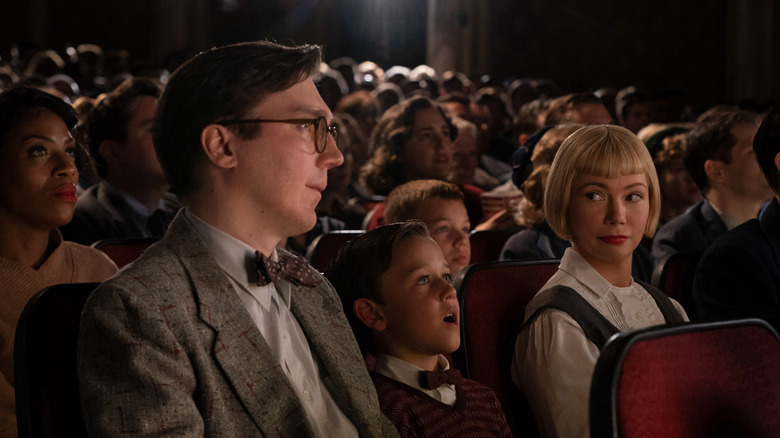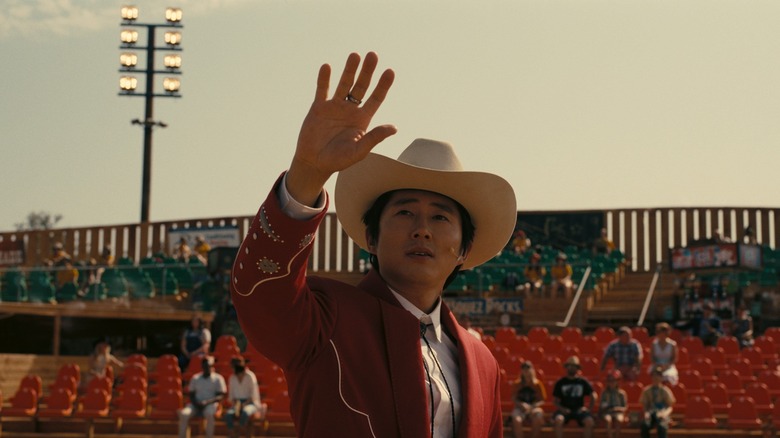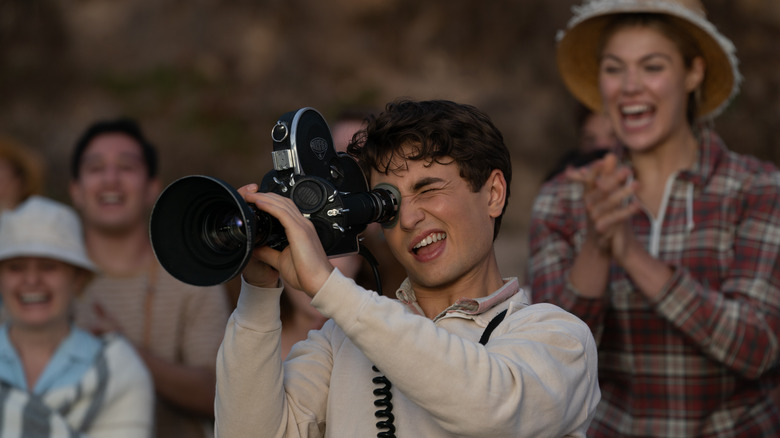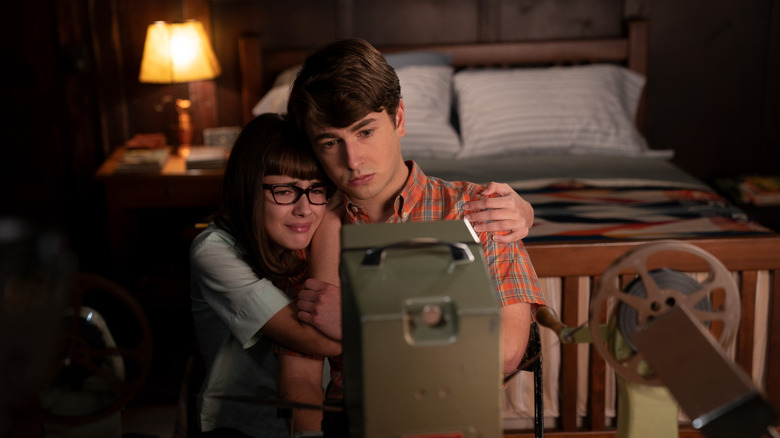The Fabelmans And Nope Are Completely Different Movies That Somehow Have A Lot In Common
This post contains spoilers for "The Fabelmans" and "Nope."
A family is dealing with a raucous member of the household, trying to settle things down so they can have a relatively normal dinner. It doesn't help matters that the well-meaning father enters the house and is baffled, slightly dumbstruck at what's causing all the ruckus: a chittering monkey who's just as likely to cause a violent melee as to playfully nip at him or his family members. The wild scene occurs in the middle of a new Universal Pictures release that is at least in part about the power of spectacle, and the awe it can create among audiences (if not automatically the dangerous power that spectacle can hold). That new film is, of course, Steven Spielberg's "The Fabelmans," though it calls to mind another truly memorable picture from 2022: Jordan Peele's "Nope".
On the surface, "Nope" and "The Fabelmans" are about as tonally different from each other as possible. "Nope" is a heady blend of science-fiction and horror, depicting the exploits of OJ and Emerald, a brother and sister (Daniel Kaluuya and Keke Palmer) trying to capture live footage of a man-eating flying-saucer-like alien that's been hovering near their homestead on the outskirts of Southern California. "The Fabelmans" is a nakedly autobiographical story in which Spielberg and co-writer Tony Kushner document Spielberg's childhood and how his sometimes-tense home life informed his desire to make motion pictures. "Nope" is no doubt inspired by many of Spielberg's best films, such as "Close Encounters of the Third Kind" and "Jurassic Park"; similarly, there are touches throughout "The Fabelmans" that explain, intentionally or not, some of the ways in which Spielberg's home life informed those very movies. In some surprising ways, these two films are mirror images of each other, making for a distinctive if unexpected double feature.
A visceral spectacle
Perhaps the most visceral reminder comes in that aforementioned scene in "The Fabelmans". Young Sammy Fabelman (played by Gabriel LaBelle as a teenager) is the oldest child of Burt and Mitzi Fabelman (Paul Dano and Michelle Williams), and throughout the course of the film, they move from New Jersey to Phoenix, Arizona to Northern California, each time due to Burt's upward rise in the world of technology. These moves come at the expense of fracturing, slowly but surely, the kind but introverted Burt's relationship with the much more outgoing Mitzi, a talented would-be concert pianist whose artistic aspirations got tossed aside to be a homemaker. Burt and Mitzi initially seem to complement each other with their different personalities, but over time, it becomes clear that Mitzi's heart is with Burt's best friend Bennie (Seth Rogen), and that she's challenged to play the good wife, acting out in strange ways. Once, it's doing a fan dance at a camping site, and another time, it's unexpectedly buying a monkey as a pet and bringing it home.
When the monkey, also named Bennie, hops onto Burt's shoulder, a slight tension falls. Part of that tension is in the look on Burt's face — not horror so much as confusion at why there's a monkey in his household, and what it may mean in the larger scheme of his relationship with his wife. (In a later dinner-table scene where Sammy's high-school girlfriend is visiting, Burt and Mitzi get into a lengthy argument spurred on by her unwillingness to bring Bennie the monkey to a vet.)
Yet some of the tension exists if you put "The Fabelmans" in conversation with "Nope." In the latter film, though many of the most disturbing images are conjured up by Peele by showing us Jean Jacket the alien sucking up countless humans to become its latest meal, or raining blood on the house of OJ and Emerald Haywood, the most discomfiting moments take place in the 1990s, on the set of a cheesy family sitcom where one of the cast members, Gordy, a chimpanzee, attacks its human co-stars and goes berserk after a balloon pops near its head. We deliberately don't see the violence as much as the aftermath through carefully placed details — the way Peele frames the scene is, in and of itself, an ode to Spielberg's best action sequences — but in hindsight, watching the humans cavorting around a chimp is a reminder of how dangerous they can be. (Understandably, the chimp in "Nope" is a CG creation brought partially to life by actor Terry Notary. In "The Fabelmans", the monkey is real, portrayed by Crystal, the same monkey who played Annie's Boobs on "Community." Crystal, fortunately, is a lot smaller than Gordy.)
Controlling the magic of the movies
Monkey business aside, "Nope" and "The Fabelmans" each belong to a subgenre of modern American cinema in their own ways: movies about movies. "Nope" may be partially skeptical of the notion of cinematic spectacle, as we see from when OJ and Emerald's neighbor, Ricky (Steven Yeun), who grew up on that sitcom set and now runs a Western-themed amusement park inspired by his filmography, lures the UFO to his park for a spectacular display of eating a horse. (He ends up being fodder for the UFO himself, along with all the gaping audience members looking up in awe, a la the classic "Spielberg face" shot.) But "Nope" itself is a cinematic spectacle, careful to acknowledge the dangerous power of spectacle while also embracing it in a dark fashion.
"The Fabelmans," aside from seeding in notions of what would inspire Steven Spielberg as a youth to make films like "Close Encounters of the Third Kind," "Saving Private Ryan," and "Indiana Jones and the Last Crusade," is equally about the power of the moving image. The opening moments depict Burt and Mitzi bringing an adolescent Sammy to his first movie, Cecil B. DeMille's "The Greatest Show on Earth," and how compelled and terrified Sammy is (in equal measure) by a set piece in that 1952 film in which a fast-moving train runs into an equally fast-moving car and causes a massive pileup. At first, the set piece seems to have inspired nightmares in him, but the more Sammy thinks about it, the more he wants to recreate the crash and control it himself, to avoid being scared and to replicate it as close as possible.
Once Sammy's a teenager, he's still very passionate about making movies, from a war film called "Escape to Nowhere" to a "Ditch Day" film as a celebration of his high school's final days before he and his fellow seniors graduate. That latter film not only inspires joy among its viewers, his fellow seniors, but it also displays a flair for both humor and horror. (One of the slyer jokes in "The Fabelmans" is when someone notes how much Sammy hates the beach, tipping a cap to Spielberg's first blockbuster hit.) There's a series of gags he stages to make it look like errant seagulls are defecating in the mouths of some of the seniors (who are in on the joke). In its own way, we're getting a tweak of characters looking up and being punished for doing so. That film — no doubt inspired by something Spielberg himself made in high school, because of those little details that feel too precise to be fully concocted out of thin air — also shows how "The Fabelmans" has to toe a very careful line in presenting Spielberg's past without being too hagiographic in doing so.
The impossible shot
A filmmaker like Jordan Peele has shown over the course of just a few movies how precise of a director he's become, and how enormously effective he is at staging tense and terrifying setpieces. But again, it's easy to watch "Nope" and spot reference points — many of which are purposeful on Peele's part. As we see in "The Fabelmans," many of those reference points are ones Spielberg created. Telling a story about how the iconic director grew up and what spurred him to make movies offers a challenging balance: how much do you show him as a young man making movies without also having every character fawn all over how amazing and talented he is? One of the most fascinating scenes in "The Fabelmans" comes right after the "Ditch Day" scene, as Sammy is confronted by Logan (Sam Rechner), one of the golden boys of the school who also torments Sammy for being smaller, nerdier, and Jewish. (Because Spielberg's childhood is his childhood, this is a largely lily-white film, but the antisemitism in these scenes is deliberately and incredibly uncomfortable.) Considering how awful Logan is, Sammy would not be blamed for ignoring him in the "Ditch Day" film or treating him poorly in the process of filming. (Sammy does so in shots of an even worse bully, Chad, who's described by Logan as "legitimately demented" — Chad is shown on film striking out with a girl, among other things.)
But Sammy makes Logan the star of the show, carefully documenting (sometimes in slow motion) how Logan wins a race on the sandy beach and winning a volleyball match. Logan has been largely terrible, but he's self-aware enough to know he doesn't deserve good treatment from the kid he's tormenting. Sammy's confused response to why he'd give Logan such a star role is "...I don't know, maybe I wanted the perfect shot!" In moments like this, as well as one scene where Sammy pores over the film he shot on the aforementioned camping trip and realizes that he's inadvertently documented proof of his mother's affair with Bennie (the human), our hero recalls another character from "Nope," the grizzled cinematographer Antlers Holst (Michael Wincott), who works on unmemorable projects because he's given up the hunt for "the impossible shot." Antlers is lured in by the promise of that very shot by OJ and Emerald, and eventually sacrifices himself to get it, using a hand-cranked IMAX camera to defy the odds (and logic, since he's dead for sure).
In the end, what "The Fabelmans" approaches is what "Nope" approaches: The knowledge that the quest for the impossible shot, the perfect shot, the great cinematic spectacle, is best shown and not explained. Consider the final, and best, scene in "The Fabelmans," in which Sammy is now in Los Angeles trying to hustle for work, and winds up in the office of one of his directing idols, John Ford (David Lynch). Ford is a terse, grouchy character who has little patience for this barely-out-of-high-school kid. After pushing Sammy to spot the location of the horizon in a couple of his paintings, he says gruffly, "When the horizon's at the top of the frame, it's interesting. When the horizon's at the bottom of the frame, it's interesting. When the horizon's at the middle of the frame, it's boring. Now get the f*** out of my office."
Explaining why those things are true is beside the point. You just innately know that looking for a clear enough answer for what inspired Steven Spielberg throughout his childhood is possible in "The Fabelmans," but beside the point. You can look for answers in spectacles like this or "Nope," but to do so is beside the point. What these films share in common is their quest for the perfect shot, in one way or another, and their careful embrace of spectacle.



